Cat Conservation Blog: Iberian lynx recovery project…is this the model for Scottish wildcats?
03/06/2016 in Conservation
As part of Scottish Wildcat Action, RZSS has been tasked with coordinating a conservation breeding programme for future releases. To do this effectively we not only have to manage the existing captive population, undertake cutting edge genetic work and liaise with landowners across Scotland; we also need to look to other similar projects across the globe to ensure we are constantly learning and developing new techniques that will aid future success.
Conservation strategies are and should always be adapting and evolving as new information and data becomes available. This is particularly true with endangered species, as their populations continue to decline over short periods of time. A plan that refuses to adapt is one that is unlikely to succeed in its objectives.
Despite this blog being about Scottish wildcats, I am actually going to start by talking about another endangered European cat species; however, the connection between the two should become apparent. I recently had the privilege of spending time with one of the most successful reintroduction projects of recent years, the Iberian lynx recovery programme in Spain and Portugal.
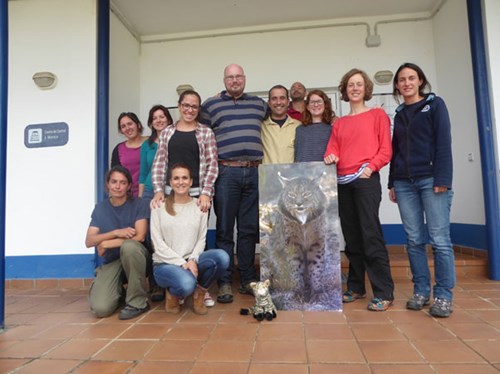
(RZSS conservation department staff with the El Acebuche Iberian lynx team by D.Barclay, 2016)
In the 1960s there were an estimated 3,000 Iberian lynx in the wild, but this dropped to 400 at the end of 1999, then down to 200 in 2002 and in 2005 it was down to an estimated 100 individuals, spread across just three small populations.
This of course was a worrying time for the species and as a result it was listed as Critically Endangered by the IUCN Red List. As part of a larger conservation action plan for the species (similar to the one we’ve developed for wildcats) and with funding from EU life grants, a conservation breeding programme was established. In 2002 the first breeding centre – El Acebuche, situated in Donana National Park in southern Spain – opened. This was followed by four more centres over the following ten years.
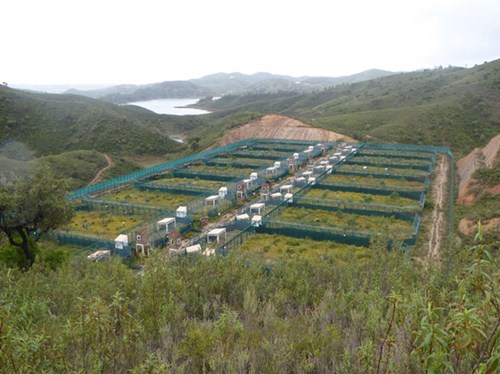
(Conservation breeding centre, Silves, Portugal by D.Barclay 2016)
Wild-caught lynx were brought into these centres with two clear objectives:
1) Provide animals for future release
2) Coordinate breeding to ensure a sustainable population with high genetic diversity
In the same way that we plan to manage Scottish wildcats, these centres focus on large natural enclosures, minimal husbandry and disturbances, remote monitoring of behaviour and breeding, and pre-release training strategies, as well as having dedicated staff doing everything in their power to save their own iconic native species.
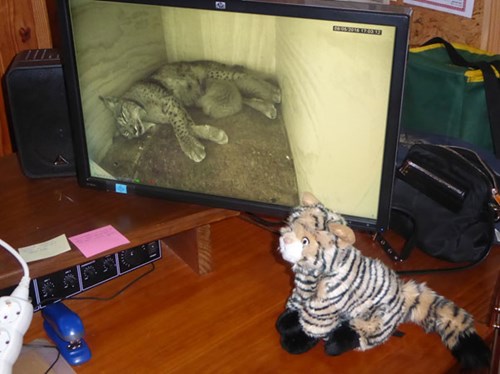
(Wallace the wildcat watches an Iberian lynx mother with kittens by D.Barclay, 2016)
Fast forward to 2016 and, following years of successful breeding and numerous releases, there are now over 400 wild living lynx across Spain and Portugal. To top that off, in 2015 the species was downgraded by the IUCN Red List from Critically Endangered to Endangered, marking a huge achievement for the Iberian lynx project.
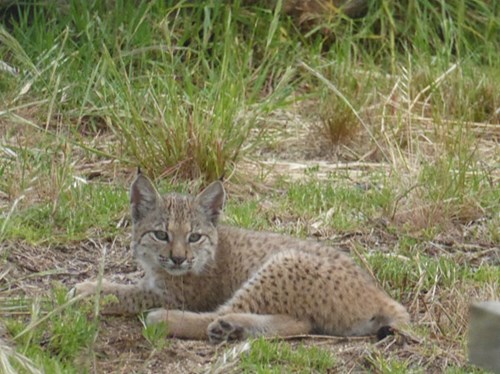
(One of this year’s kittens bred for reintroduction by D.Barclay 2016)
The success of this programme speaks for itself and, having spent time with the staff at the El Acebuche and Silves breeding centres, I can tell you first hand that their professionalism and determination are a true testament to global cat conservation efforts.
The timeline of events and population decline with Scottish wildcats highlight an alarming similarity with the Iberian lynx. Between 1995 and 1997, the population was estimated at 3,500 and 4,200 individuals; in 2005 there were an estimated 400 and in 2016 the population was estimated as being between 115 and 314.
Given the similarities we have no doubt asked ourselves many of the same questions regarding conservation, threat reduction, awareness, education and conservation breeding for release. It is also clear that both projects have a long road to travel. What is important, though, is that both the Scottish wildcat and the Iberian lynx are on the same road.
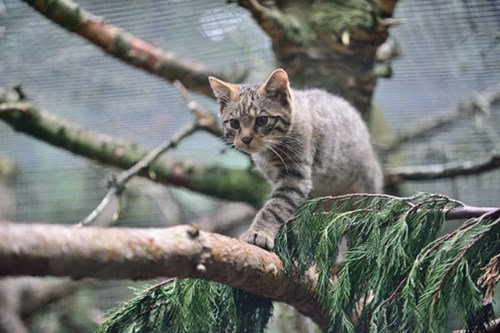
(Scottish wildcat kitten at RZSS Highland Wildlife Park, 2015 by A. Riddell, 2015)
In the same way that our colleagues in Spain and Portugal had to deal with many challenges with the Iberian lynx, we too will have many obstacles to overcome, but my recent visit to the lynx centres not only showed me what can be achieved with a great action plan and lots of passion, but reaffirmed why I am proud to work in the field of cat conservation and be a part of RZSS and Scottish Wildcat Action.
As always, stay tuned for more insights into the world of cat conservation,
David Barclay
Cat Conservation Officer
 Thank you to the players of the People's Postcode Lottery who are helping us to deliver these important cat conservation projects.
Thank you to the players of the People's Postcode Lottery who are helping us to deliver these important cat conservation projects.
Featured Articles

An update from the Budongo Forest
19/04/2024 in Conservation

Edinburgh Zoo named best zoo in Scotland
15/04/2024 in Edinburgh Zoo
Latest News
-
News

27/03/2024
HRH The Princess Royal visits project to restore wildcats to Scotland
HRH The Princess Royal visited the Saving Wildcats project, based at the Royal Zoological Society of Scotland’s (RZSS) Highland Wildlife Park, to learn more about the partnership project working to save one of the UK’s most endangered carnivores.
-
News

13/10/2023
Critically endangered wildcats now call the Cairngorms National Park home
The first round of wildcat releases in Scotland has been completed by Saving Wildcats, led by the Royal Zoological Society of Scotland (RZSS) in partnership with NatureScot, Forestry and Land Scotland (FLS), The Cairngorms National Park Authority, Nordens Ark and Consejería de Sostenibilidad, Medio Ambiente y Economía Azul de la Junta de Andalucía.
-
Blog

24/07/2023
What’s on the menu for the European wildcats
European wildcat is a secretive species, and so it is difficult to observe their hunting and feeding behaviour in the wild. Analysing their scats is an alternative way to find out what they eat and therefore how they fit into the ecosystem. RZSS WildGenes scientists developed a technique to detect DNA of different prey species in scat samples.
-
News

22/06/2022
Ten more wildcat kittens born at Saving Wildcats conservation breeding for release centre
Keepers at the Saving Wildcats conservation breeding for release centre have captured images of one of two new litters of wildcat kittens, who could be among the first of their species to be released into the wild in Britain.

























Follow EZ